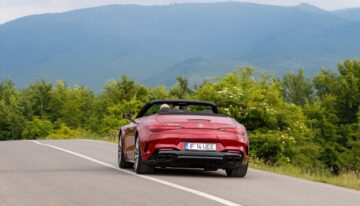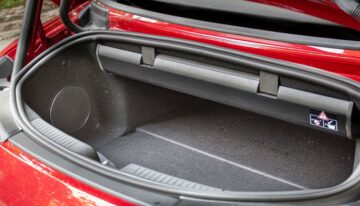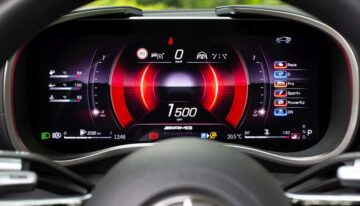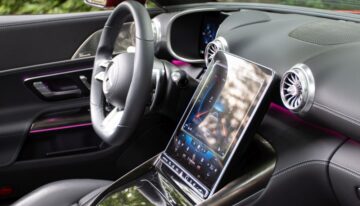Mercedes wanted to get back to the essence of the iconic SL, so it developed a dedicated, all-new sports platform that makes the new SL sportier than all its predecessors. That means a technology package with all the best Mercedes has to offer in terms of the drivetrain. At the same time, the new SL it’s even more practical in the new 2+2 seating configuration. Review of the top version Mercedes-AMG SL 63 4Matic.
Photo: Bogdan Grigorescu
There are probably few cars in the world that have had so many famous owners, from actors, singers, princes, kings, emperors, and businessmen. Clark Gable, Herbert von Karajan, Romy Schneider, and Tony Curtis had a 300 SL but also Gunter Sachs or Alfred Krupp. What’s more, the 300 SL was named the sports car of the 20th century. The name 300 SL stands for Sport and Leicht (light) and Mercedes wanted to revive the spirit of this legend.
That’s why the German manufacturer took a radical decision and developed a new dedicated sports platform called MSA (Modular Sports Architecture) while the previous generation was based on a platform derived from the E-Class. So, the driving position is extremely low with the seats mounted on the floor and the drivetrain has all the high-tech AMG ingredients: variable all-wheel drive, integral steering with 2.5 degree steering angle, active anti-roll bars and AMG Ride Control adaptive suspension that connects the dampers to both compression and decompression via two hydraulic circuits. What’s more, they’ve mounted the V8 engine as far back as possible for the best possible weight distribution. But enough of the technical explanations, let’s get to the emotional aspects.
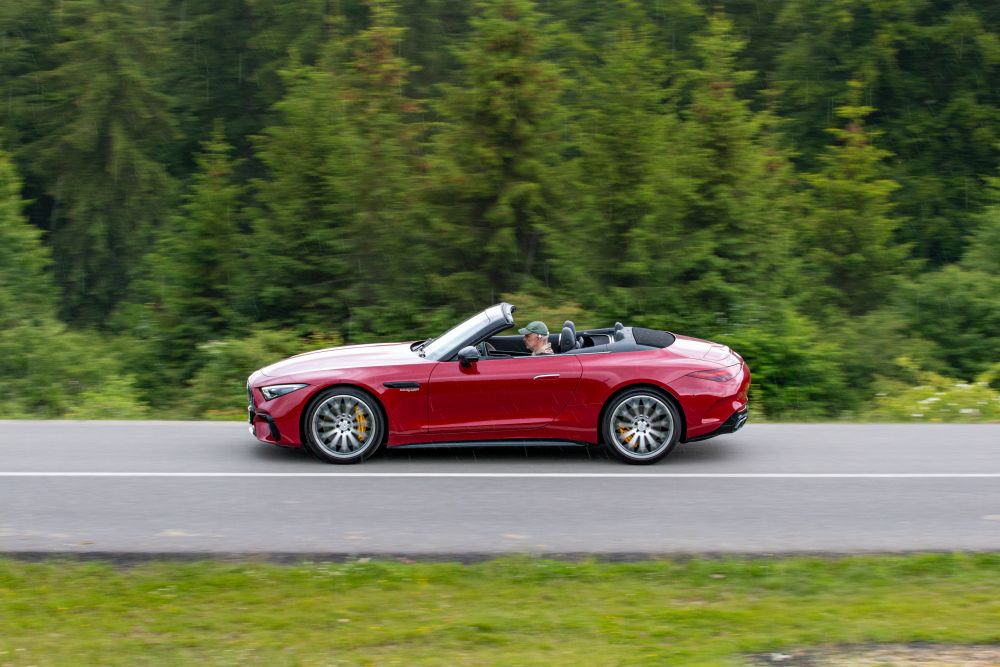
Luxury remained a priority
We approach the car and the illuminated door handles, hidden in the bodywork, pop out. More spectacular than Aston Martin! We open the wide door and drop down into the superbly configured, floor-mounted AMG sports seats. There’s so much room up front it’s like you’re in the S-Class. In this respect, the new Mercedes-AMG SL 63 4Matic retains the luxurious character of its predecessor. If you’re over six feet tall, you can push back the front seats until the backs touch the two small rear seats that have a very steep backrest. It’s very hard to accomodate there even two small children because of the steep backrest and narrow kneeroom but Mercedes opted for this 2+2 configuration because customers demanded it. At best, these seats can serve as storage space.

Once you sit down, you’re faced with a steering wheel as thick as BMW M models, but with dual arms overlaid with the familiar touch surfaces from other Mercedes models. Behind the steering wheel sits deeply integrated into the dashboard the 12.3-inch instrument cluster display with AMG-specific menus, “Supersport” and “Track Pace” in addition to the traditional “Sport” layout. At the center of the dashboard is the 11.9-inch portrait screen from the S-Class, which in the SL can be electrically tilted at various angles.
When you open the softtop, the screen automatically positions itself closer to vertical to avoid reflection from the sun. But it still heats up strongly on hot days. Or you can adjust the angle between 12 and 32 degrees by pressing a button on the button bar and then swiping on the touchscreen. Also by pressing a button on the same bar and swiping on the touchscreen, you can open the softtop in just 15 seconds to a speed of 60 km/h.
Speaking of the roof, Mercedes is returning after 20 years to the textile roof (the last one was the SL R129 1989-2001) and it’s of very good quality, with three layers and a material density of 450 g/sqm. However, at over 120 km/h there is a slight hissing sound at the front pillars when the roof is closed. If you lower the roof but leave the side windows up and fit the wind deflector, you can drive at up to 130 km/h without any draught bothering you.
But now comes a tough choice. Which is it? Listen to some good music on the Burmester sound system or listen to the sound of the twin-turbo V8 through the four square exhausts on the Mercedes-AMG SL 63 4Matic?
And so we move on to the many dynamic settings that require a little documentation. You have a touch, deep in the dynamic menu settings, from where you can adjust the rear spoiler, either manually or according to driving modes, from the standard -11 degrees to +6,+11,+17 to the extreme +22 degree position for the racetrack.
You also have six driving modes: Slippery, Comfort, Sport, Sport+, Individual, and Race, but you can adjust separately engine response (Reduced, Moderate, Sport, Dynamic, Race), suspension (Comfort, Sport, Sport Plus), AMG Dynamics (Basic, Advanced, Pro, Master) and ESP separately. You can also do this from the two Chrono package-style buttons on the steering wheel like on a Porsche: right for driving mode, left for individual settings. Or you can switch the 9-speed automatic transmission to Manual, or activate the sporty exhaust sound that’s real, controlled by flaps rather than an artificial noise through speakers.
The high-tech feel is everywhere as if you’re in command of a spaceship. You’ve got so many tuning options to suit even a novice driver, but it also offers total freedom if Lewis Hamilton would like to enjoy the dynamic qualities. Only the smoky metal-look inserts at the base of the touchscreen and on the door panels hold back any fingerprints, and we’d have been glad if Mercedes had chosen differently materials here.

Complex character
Under the bonnet, pushed back behind the front axle, works the twin-turbo V8 engine tuned for the high performance required: 0-100 kph (0-62 mph) in 3.9 seconds and 295 kph/183 mph top speed, achieved thanks to 585 ps/577 hp and 800 Nm/590 lb ft from 2,500 to 4,000 rpm.
Press the starter button and the engine starts with a thick AMG rumble. Press the engine sound button and the rumble picks up a few extra bass, which also happens if you select Sport+ or Race modes.
We start into Comfort mode. But when you start off, there’s some hesitation of the engine. The automatic gearbox looks for more economical gear, but this can be irritating. There’s no electric assist for the engine (there is even no 48V mild hybrid system), and perhaps a sequential gearbox likein case of the AMG GT would have been more appropriate.
After starting, however, things normalize. On Sport+ or if you switch to the Manual mode of the gearbox, it shifts like a sequential one, very quickly and brutally like a race car. The gears follow each other in quick succession as the revs increase at a dizzying speed. The twin-turbo V8 engine does a great job of handling the 1,950 kg/4299 pounds, which is no small amount.
- Superb steering
- High drive train reserves
- Powerful engine, very easy to rev
- Luxury front seats and plenty of space in front

MAX vs MIN
- Too firm suspension
- Hesitation of the engine at start
- Extremely high price

But the character of the new Mercedes-AMG SL 63 4Matic is complex and a little contradictory. On the motorway, you can’t drive it like a GT because the suspension, especially on the rear axle, is very hard and stiff even in Comfort mode. Short bumps feel directly in the spine and rear axle vertical acceleration is too high with the optional 21-inch wheels. Sure, it’s a supersport car, but there are supersport cars like Ferrari 296 GTB that go over short bumps more elegantly. Perhaps the 21-inch wheels, the largest available, also have a negative effect on comfort.
We’re getting off the motorway and tackling a twisty road. It’s time for Sport and Sport+ because Race is for the track. First corner, first feeling: the steering is fabulous. Short, punchy, and incredibly direct. Reminds me of the sensational Mercedes CLK DTM AMG almost 20 years ago. The car turns short and direct at the slightest steering input, the feedback is superb, and the pleasure is combined with a high-level feeling of safety.
The front axle is incredibly responsive and the rear axle is extraordinarily stable. Thanks also to the very low center of gravity and the engine positioned behind the front axle, which gives excellent weight distribution (54.1/45.9%), the AMG SL hardly understeers at all and does not deviate a single millimeter from the trajectory commanded by the steering.
We had a few instances where the huge 305-wide tires on the rear squealed slightly but the drivetrain reserves are impressive. A word of advice: don’t try to find them except on the track because the car develops lateral acceleration and dizzying speeds until you reach the limit. In this respect, the new AMG SL is a pure sports car despite its weight, unlike any modern generation.
The V8 engine is very powerful and above 4,000 rpm it unleashes and pushes you forward as if someone has thrown you out of a steam catapult. It revs up with disarming ease for a large displacement V8 and has an extremely spontaneous response. But without a mild hybrid system, consumption is relatively high at 16 liters/100 km (14.7 mpg). In absolute figures, it seems a lot, but at nearly 600 ps/591 hp it’s excusable.
But if you run it in Comfort mode with the engine on ‘Reduced’ then you can get 12.5-13 l/100 km (18.82-18.09 mpg). All in all, I think Lewis Hamilton would enjoy the new sporty character, steering, and incredible agility of the new generation SL which has veered towards the sporty values of its illustrious predecessor. But I don’t know if Sophia Loren would be comfortable with such a rigid suspension. Perhaps here Mercedes should have made a bigger splash on the suspension settings between sport and comfort.
Verdict
The new Mercedes-AMG SL 63 4Matic is sportier than all its predecessors despite its largeweight. The sophisticated drive train masks the large weight to some extent. But the extremely firm suspension tuning even in Comfort mode affects the GT qualities. In the end, it’s not clear: Mercedes wanted to build both a sports car and a GT, but the massive weight is a big enemy and the suspension is too firm for a GT.
| Model | SL 63 4Matic+ |
| Engine/no. of cylinders | V8, bi-turbo |
| Displacement (cmc) | 3,982 |
| Max. power/revs (PS/rpm) | 585/5,500-6,500 |
| Max. torque (Nm/rpm) | 800/2,500-5,000 |
| Traction | 4wd |
| Transmission | 9 gears, automatic |
| L x W x h (mm) | 4,705 x 1,915 x 1,359 |
| Wheelbase (mm) | 2,700 |
| Boot volume (l) | 213-240 |
| Kerbweight (kg) | 1,970 |
| Acceleration 0-100 km/h (s) | 3,6 |
| Top speed (km/h) | 315 |
| Fuel consumption WLTP (l/100 km) | 12,7-11,8 |
| CO2 emissions WLTP (g/km) | 288-268 |
| Price (euro with VAT) | 194,535.25 |















